Judgment Day. Start. Part of 2
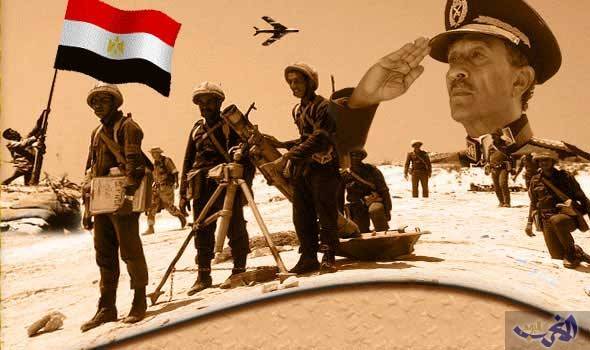
And so, strictly speaking, the Arabs did not succeed in the Golan Heights: after the first stupid days, the Israeli command came to its senses, and by October 8 it began quite firmly and sensitively to beat the Syrians.
All the most interesting was unfolding on the Sinai Peninsula. The Egyptians easily broke through the defenses of the Israelites and moved forward. October 7-8, an attempt to counterattack from the depths tanks I came across a prepared defense of the Egyptian infantry, saturated with portable anti-tank systems, which led to unusually heavy losses in manpower and equipment.
By October 10 the front after the hardest battles stabilized with difficulty. The situation was precarious, and any meaningful activity of the Egyptians could again overthrow the Israelis and open the way to the north for the Arabs ...
As I wrote in previous articles, there is quite extensive material on the topic of the Doomsday War. However, according to the team of authors of the monograph “Arab-Israeli wars. Arab look ”, he suffers from a number of disadvantages:
As you can see, the team of these authors has no particular love for Israel, and if they write like this, then we can safely believe them:
In other words, like a classic: “If Nikanor Ivanovich’s lips were to be attached to Ivan Kuzmich’s nose, and to take some swagger, which Baltazar Baltazarych had, yes, perhaps, add Ivan Pavlovich to his birth…”
Nevertheless, the work of Arab researchers are very interesting. I mean that part of them that soberly studied and described the events that took place, and did not write to order the triumphant reports. You can not ignore the literature written by the direct participants in the hostilities. The events of the October war 1973 of the year (as the Doomsday War is called in the Arab world) were dedicated to their research by Lieutenant General Saad al-Shazli. “An active participant in the war, the author describes in detail the activities carried out by the Egyptian military-political leadership in preparing for war, generally objectively covers the course of hostilities, analyzes the successes and mistakes of the parties.” - read the annotation to the Russian translation of his book “Forcing the Suez Canal” released in 1979 year. By the way, the book was banned in Egypt.
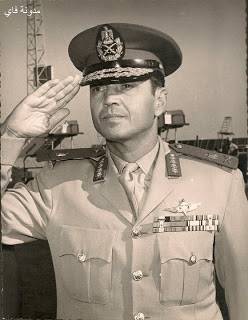
He graduated from the military college, then studied at the Royal Military Academy, took part in the Second World War, in all wars with Israel, fought in Yemen, Congo, and studied in the USSR in the courses “Shot”. 16 May 1971 was appointed Chief of Staff of the Egyptian Army. Together with the Minister of Defense, Ahmad Ismail commanded the Egyptian army during the crossing of the Suez Canal and the breakthrough of the Bar-Lev line. But then he spoke against the proposed plan of hostilities. Dismissed 13 December 1973 of the year. He was ambassador to the UK, then ambassador to Portugal. In 1978, while in Europe, he sharply criticized President Anwar Sadat. He was removed from all posts and was forced to emigrate to Algeria, where in September 1980 of the year announced the creation of the opposition Egyptian Popular Front, whose leadership included mostly disgraced officers, became his general secretary. After publishing his memoirs in 1983, he was sentenced in absentia to three years hard labor for "divulging military secrets" and publishing memoirs without prior permission from the Ministry of Defense. After returning to Egypt, 15 March 1992 was arrested. 13 August 1992, the Supreme Court of Egypt and the State Security Court sided with him and ordered him to be released from prison immediately (the military authorities refused to comply with the decisions of the courts). He served a year and a half in solitary confinement. In, how!
I want to invite readers to go back a little and once again look at the events of the first days of military operations in Sinai, but already through the eyes of a direct participant in the events. Lt. Gen. Saad al-Din Mohammed al-Husseini al-Shazli. Please love and respect:
At 13.00, President Sadat, accompanied by General Ahmed Ismail, arrived at the 10 Center and headed straight to the Operational Room.
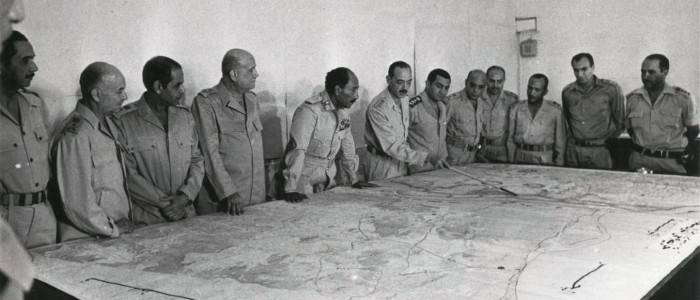
We have been in their places since the early morning. Places for high command were located on a small dais. The members of the command of each branch of the troops were located near their communications consoles, and the halls of military operations were hung on the floor. On the glass screen the huge map was constantly updated, which made it possible to see at a glance the situation on both fronts at a glance. The background was created by phone calls, the cracking of telexes and the muffled voices of people trying to hide their tension.
Hour "X", when the first wave of infantry should appear above the sand mound on our side, get to the water with its inflatable boats and land on the opposite side - which may be the longest journey in their lives - was assigned to 14.30. But while we waited, ordering ourselves to remain calm, much was already in motion: the naval forces, artillery, special forces, engineering intelligence units — all were final preparations.
Our pilots in the cabins of their fighter-bomber methodically fastened, connected life-support systems, carried out pre-flight testing of instruments and controls, while the equipment for the armament rolled out their empty carts from under the loaded wings. A clock high on the wall of the command post showed 13.50. On the desk of the commander of the Air Force, the telephones rang - reports from the air bases went: "Ready for takeoff." A picture appeared before my eyes: the planes were rolling out of the gloomy hangars in the sun; they appear black against the background of its radiance, the straight lines of the wings appear broken due to the hanging projectiles. Then the hum, dust, exhausts covering the scorched terrain, when the cars drive along to the beginning of the runway next to them, turn slowly on the front landing gear and roar along the runway.
Exactly at 14.00, two hundred of our planes flew over the canal at a low altitude, casting a shadow on the enemy line, heading deep into Sinai. For the fourth time in my military career, we were at war with Israel. ”
As you can see, the general writes brightly, beautifully and in arabic colorful. Of course, the scope of the article on HE does not provide an opportunity to put his entire story here. I allowed myself to remove from the text almost all the excellent forms of adjectives and adverbs, to squeeze out the water of minor details, but I tried not to dry up the narration, which is conducted from the first person, to ascetic military reports:
We focused more 2 000 guns behind our lines. Now, howitzers and heavy mortars attacked the forts of the Barlev line, mine fields and wire awards.
14:05. Under the cover of artillery, the first soldiers began to cross the canal, and soon the first detachments crossed the enemy’s embankments: these were commando detachments that were sent beyond the front line of the enemy.
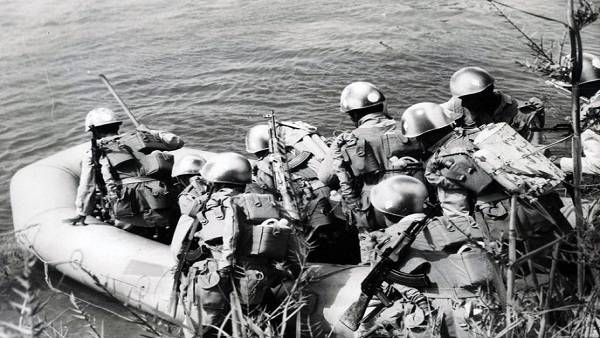
Approximately in 800 meters behind the sand bank, the enemy built separate sand mounds intended for firing, from which his tanks could hit those who overcame the first obstacle. Our commandos, loaded with portable anti-tank weapons, were the first to reach these platforms.
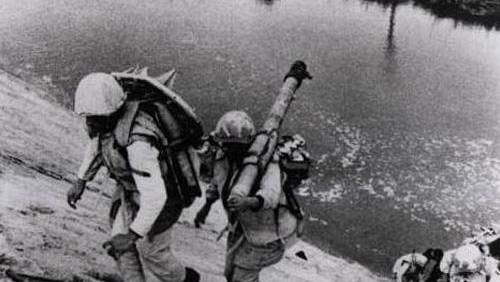
Along the western shores of the Bitter Lakes and Lake Timsah, the situation was calmer. Brigade of floating armored vehicles - 20 light tanks, 80 BMP and 1000 manpower headed towards the east bank. At almost the same moment, a company of marines began a shorter crossing over Lake Timsah in ten floating vehicles.
While the fire of our howitzers and mortars did not let the enemy infantry out of their shelters, the rest of our artillery forces moved into firing positions. In 14: 20, they opened direct fire on strongholds of the Barlev line. The 4000 soldiers of the first wave moved over the mounds on our side and descended to the water. 720 boats were prepared, and under the cover of a powerful smoke screen, our people in the first wave of the attack started up with oars, forcing the canal.
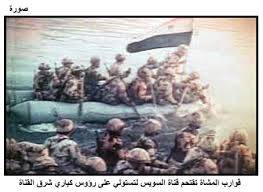
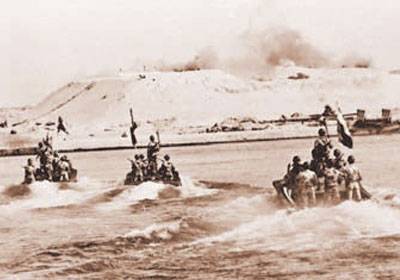
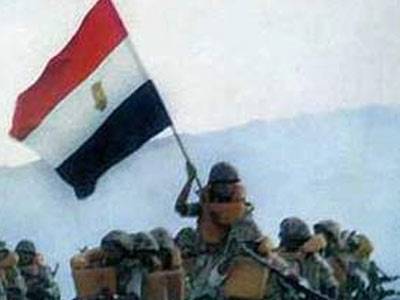
In the area of Lake Timsah, a company of marines landed on the opposite bank. In the desert ahead of the advancing troops, the first commando groups had already captured the embankments assigned to them and installed their anti-tank weapons on them. They had time just in time. Forward moved the tanks of the enemy. The enemy began to put into effect his plan "ShOvah YonIm" ("Dovecot" - my note).
We knew in detail the enemy's defense plan. He was a routine staff development. The enemy divided the Suez Front into three sectors: the northern, central and southern, and in each sector there were three possible directions of advance in the Sinai.
- The northern sector provided defense in the direction of Kantara - El Arish.
- The central sector - in the direction of Ismailia - Abu Ajail.
- The southern sector - opposition to the throw from Suez to the passes of Mitla and Jedi.
- In each sector, defense consisted of two lines and a reserve.
FRONT LINE: 35 forts and strong points of the Barlev line were located along the canal. Between the forts at a distance of about 100 m equipped with firing positions for tanks.
SECOND LINE: 5-8 km at a distance behind the canal. Three battalions of 40 tanks in each. One battalion in each sector. (in fact, 30 tanks. my note)
RESERVE: at a distance of 20-30 km behind the canal. Three tank brigades of 120 tanks each (on 6 of October there were only 276 tanks there. my note.) minus the battalions nominated for the second line. In fact, each brigade, one in each sector, was divided as follows: 40 tanks in front, the rest 80 - in reserve.
FIGHTING READINESS: second-line defense forces occupy their firing positions at the water line or on embankments directly behind it. Then the front line of defense will include an infantry brigade in the fortifications of the Barlev line and 120 tanks of three tank battalions. On the second line remain 240 tanks of three armored brigades. All other reinforcements must come from Sinai.
RESPONSE RATE: According to our forecasts, the enemy will be able to counterattack with units of tank companies or battalions and the flow of 15-30 minutes from hour X. Massive counterattacks by brigades can begin approximately two hours after the start of your offensive.
To neutralize these forces, we planned to move five infantry divisions through the canal.
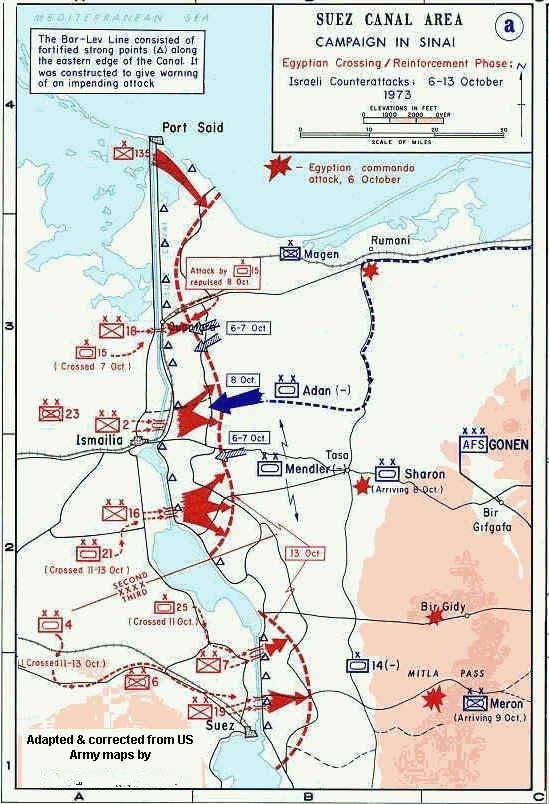
Troops should be transported across the canal on as wide a front as possible, almost the entire length of the canal. But our attack will be concentrated in five sectors, in each of which a division operates. From north to south, our forces were positioned as follows:
- 18-division begins and then takes up defensive along the axis of Kantara - El Arish;
- The 2 Division also operates in the direction of Ismailia - El Taza;
- 16 Division - along the Deversoir-El-Tasas axis;
- 7 Division - along the axis of Shaluf - Jedi Pass;
- 19 Division I - along the Suez axis - Mitla Pass.
In addition, we dispatched a brigade of amphibious tanks and a company of marines to cross the Bitter Lakes and Lake Timsah. Three northern divisions were the Second Army. Two southern belonged to the Third Army. However, it would be wrong to consider them only infantry divisions. Each division had to prepare and hold a bridgehead, reflecting a powerful enemy tank attack. Therefore, we reinforced each of them with one brigade of tanks (three battalions), one battalion of self-propelled anti-tank guns SU-100, and an ATGM battalion. In addition, the infantrymen themselves had all the anti-tank and anti-aircraft weapons that they could carry or carry with them.
14:45. Our forces of the first wave - 4 000 soldiers landed on the other side of the channel between the strong points.
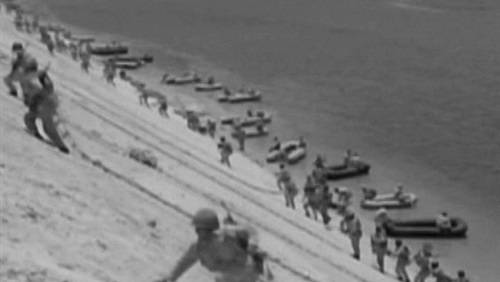
Boats, managed by two soldiers of the battalion of engineering troops, returned. About five minutes later, clouds of dust announced the movement of enemy tanks to the channel. The soldiers began firing at the approaching vehicles. But the main task of repelling this first tank counter-attack lies on tanks and units armed with heavy anti-tank guns and anti-tank missile systems that fire across the Bar-Lev line from our embankments on the western bank of the channel.
Under the cover of this fire, which is also being conducted on strongholds, engineering platoons begin to bring their pumps to the far shore in order to flush the 70 passages in the sand shaft. The plan gave them the total 5-7 hours.
On the Bitter Lakes, a crew of amphibious tanks began landing on the eastern shore.
Aircraft returned after the first strike. Because of the short range, all their targets were at Sinai: enemy airfields, air defense systems. electronic jamming stations, and troop headquarters.
On the west bank, infantry of the second wave is preparing. One of the soldiers in each boat holds a sign with the luminous number of his boat, which he must stick on either of the enemy’s shores, as a marking sign of the landing place. Next to this sign, other soldiers in the boat unfold rope ladders attached to the top of a sandy embankment. It is absolutely necessary that the boats follow the routes accurately, in part, so that every wave of troops does not lose those who landed ahead, but also because nothing should interfere with our engineers when making passes. Between the boats of each company we provided for a gap of about 23 meters, between battalions - at 360 m, between brigades - at 700 m. Between the divisions, actually between bridgeheads, the distance was 14.5 km. In this gap, our engineers must make passes, assemble ferries, prepare light bridges and heavy bridges, transfer them across the canal and put them into operation.
14:45. The second wave of troops landed on the east coast. Subsequent waves should land every 15 minutes.
15:00. The first strong point of the Bar-Lev line was taken.
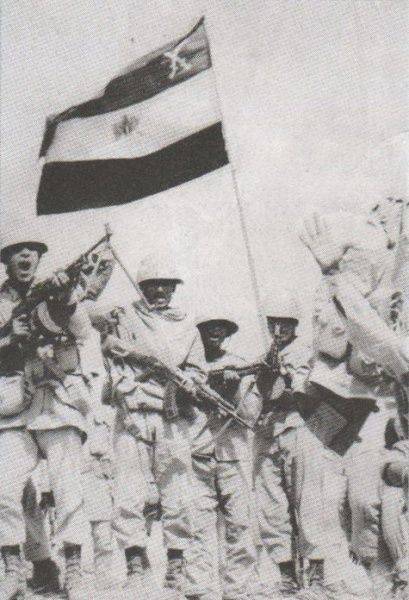
We take the first prisoners. The enemy air force inflict the first airstrike. In these first minutes, our SAM batteries bring down four aircraft.
15:15. The landing of the fourth wave. The fifth wave is ready to force. So far, our bridgeheads are only 180 meters deep. But the fourth wave consists of 20 infantry battalions - 800 officers and 13 500 soldiers who carry or drag light weapons of support to Sinai. An artillery duel continues between the enemy forces and our guns on the embankments on the west bank.
15:30. Our engineers have reported progress in washing the aisles, and the bridge battalions are given a signal to prepare for the transition from the concentration areas to the collection points near the canal.
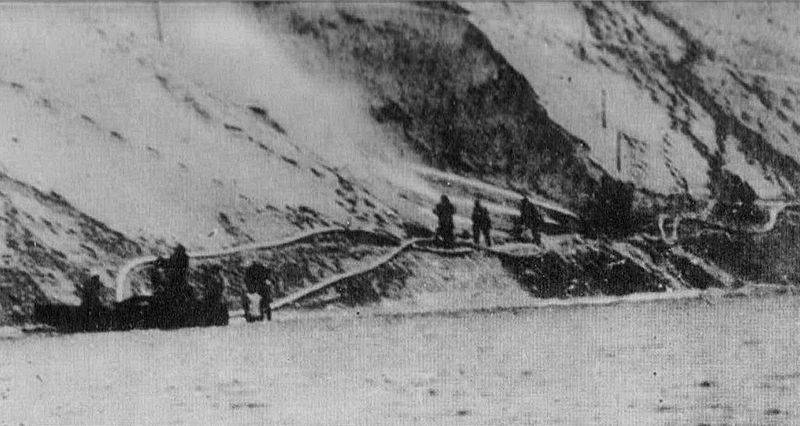
16:00. New waves of enemy air strikes. There are new victims of our air defense missile systems, new strong points of the Bar-Lev line have fallen.
16:15. Landing the eighth wave. Now we have ten infantry brigades on the other side of the canal: around 1500 officers, 22 000 soldiers with all their weapons. Behind the advancing infantry lines, five divisional bridgeheads are organized. Now each bridgehead has a length of 8 km along the canal and a depth of more than 1.6 km. A cover fire continues from the west bank, but our advanced units bear the brunt of the reflection of enemy armored attacks. Artillery takes fire to more distant targets at Sinai. The advanced infantry forces act as gunners on the target. The long-range patrol units that entered Sinai last night are preparing to thwart the enemy’s reinforcement approach.
16:30. Ten bridge battalions of engineering troops approach the canal and begin to launch sections of bridges. At the same time, engineering parts responsible for assembling 35 ferries bring their finished parts to the water.
16:45. As soon as the bridge sections are launched, the engineering battalions begin to pre-assemble two or three sections in one go.
17:00. Engineers begin assembling ferries. Our troops take new strongholds of Lin-Lev.
17:15. Preparations for the concentration of tanks and equipment began on the east bank. Parts of the military police are transported through the canal in boats along with the latest waves of infantry, carrying with them markings with code numbers and colors. They begin to install them to designate the routes of vehicles suitable for bridges and ferries.
17:30. The twelfth wave of the offensive forces crossed the canal and overcame the embankment. In three hours we sent five reinforced infantry divisions across the canal - 2 000 officers and 30 000 soldiers with all possible weapons, plus personnel and equipment of five anti-tank guided missile battalions.
The initial phase of the attack ended successfully. Each division now holds a semicircular bridgehead 8 km long along the canal and from 3,5 to 4 km deep in Sinai. Now everything depends on how soon our engineers will be able to open the movement for tanks and heavy artillery, which must join the already leading battle gunners.
17:50. Taking advantage of the twilight, our helicopters drop four battalions of commandos in the depths of Sinai. These units must come together and begin hostilities under the cover of darkness.
18:00. Our tanks, anti-tank guns and other equipment of the first category of importance begin to move from areas of concentration to their designated crossing points.
18:15. Engineering parts have almost completed the assembly of the ferries. They should start crossing our tanks at the moment when the passages in the embankment will be open.
18:30. Success is achieved: the first pass is open. The soldiers of the engineering platoon managed to do it in four hours. Infantry on the bridgeheads also succeeds. Now every bridgehead has a depth of 5 km. Almost each of the strongholds of the Bar-Lev line, which is still holding, is deprived of any hope of salvation on the coming night.
18:30-20:30. All passages in the sand mound are open, except for passages in the far sector at the southern end of the channel, where the sand turned into a clay mass that cannot be cleared. So instead of 70, we had 60 passes. This meant that in this sector we would not have four ferries and three bridges - two heavy-duty vehicles and one light, through which equipment should be transported to the aisles. But in all other places, our engineers completed their task. 31 ferry worked with a maximum load. Tanks and equipment of the first category of importance are crawling from the crossing points. The bridges are fully assembled and transferred across the canal. The engineering troops proceeded to the final stage, setting them in the desired position, securing them and laying ramps in the aisles. Communications officers of the ferry command took up positions on the east bank to direct the traffic on the routes assigned to them.
20:30. Exactly two hours after the opening of the first passage, the traffic opened on the first bridge. The first 200 tanks of the respective division crawled to the other side.
20:30-22:30. Over the next two hours, all the bridges opened to traffic.
(Except three, stuck in the mud in the southern sector). In eight hours, the engineers succeeded:
- pierced 60 passages in a sand mound, flushing more than 15 000 cube. meters of sand;
- built eight heavy-duty bridges;
- built four light bridges;
- assembled and put into operation 31 steam.
All this activity reached its highest point in 22: 30, when the last columns of equipment moved along these canals along these canals. Artillery skirmish acquired a periodic character. But the enemy continued to inflict airstrikes, now mainly on bridges. Anticipating this, we accordingly moved our SAM systems. K 22: Our air defense 30 shot down enemy aircraft 27.
22: 30 October 6 - 08: October 00 7. This Sunday, 800 of our tanks and 3000 of other units of equipment on four of our five bridgeheads - forced the channel. Problems remained only in the southern sector. Forcing there did not stop, but it went very slowly. The passages were open, but slippery ground made it difficult. Finally, the armored offensive infantry assault expanded the bridgeheads to 8 km inland to the east of the canal. Enemy armored formations are disorganized and confused. But we noted that at night the commanders of units, even individual tanks, continued to fight. Twice the enemy tank groups were able to break through our infantry lines, approach the edge of the water and bombard our bridges and ferries, causing us significant damage, but these actions were useless. Infantry responded with RPG-7 portable anti-tank grenade launchers and RPN-43 anti-tank grenades. Before sunrise, the tanks remaining on the move retreated.
(All events of this day from the October War memorial diorama)
Sunday October 7
08:00. We won the battle to force the channel. Three armored brigades and one infantry brigade, defending the Bar-Lev line, were practically destroyed: 300 from 360 enemy tanks were destroyed, thousands of soldiers were killed.(Well, here the general is slightly embellished with tanks and fighters. In total, there was an Israeli reservist who served 451 service. My note) Our losses were five aircraft, 20 tanks, 280 dead - that is, 2.5 percent of the aircraft that made sorties, 2 percent of our tanks and 0,3 percent of the combat strength of the troops. For 18 hours, we transferred soldiers, 90 tanks and many other vehicles through the 000 channel 850.
Confusion reigned in the enemy troops, in fact, he did not have armored vehicles in the combat zone.
The paradox was that now this posed a problem for us. The Intelligence Agency predicted the main attacks of the enemy's mobilized reserves during X + 6 - X + 8 hours. This morning, 18 hours after the start of the offensive, there was no indication that the enemy’s reserves were entering the battle. Thus, we have a question: when will the enemy conduct a massive counterattack - 8 or 9 numbers?
For both sides, Sunday was the day of urgent preparation for the main battle. The very success of our actions to deceive the enemy has given the enemy some advantage in this preparation. Its main benefit was that the disposition of our forces was obvious to the enemy: five fronts, one significantly reinforced division on each; tactics on the flanks; caution moving forward; nature, density and effectiveness of air defense missile systems and anti-tank guided weapons. The enemy could plan his counterattack, having a complete picture of our forces. On the contrary, if his reserves came into effect in the later stages of our initial offensive, he would have counterattacked, having no idea about our plans and what our infantrymen can achieve.
I must say that the calm this Sunday allowed us to do three things. We have almost abandoned attempts to use bridges at the end of the southern sector. Instead, we used Sunday to send tanks and heavy vehicles to the 19 Division, located in this sector, over the bridges of the 7 Division in the north. Meanwhile, the divisions in each army group expanded their bridgeheads to shorten the 15-kilometer distances, which were determined between them at the initial moment of the offensive. (I managed to sleep a few hours, go home to take a hot bath and change clothes. It was the first and last time I spent the night at home, starting October 1 and December 12.)
In 24 hours we transported soldiers, 100 000 tanks and 1 020 vehicles through the 3 channel — the largest number of manpower and equipment in the first day of forcing in world military history.
This Sunday, our other task was to organize supplies on the battlefield. Our soldiers forced the canal, having a supply of food for just 24 hours, 2,25 liters oxen and everything weapon and ammunition that they could carry or haul. Now I had to feed the 100 000 man, fill the 1 020 tanks and 3 500 machines. But the administrative service that was supposed to do this was disorganized. Almost all support services to the fifth category of importance crossed the channel. But losses and problems in the southern sector led to confusion. Our combat units ran out of supplies.
On Sunday, a lull was observed in the combat zone, but the enemy's air strikes continued, and our special forces were fighting in different places in Sinai. Our brigade of amphibious tanks was heading east of the Bitter Lakes and divided, to simultaneously advance in the direction of the Mitla passes and Jedi. Its combat mission was to disorganize the enemy command in the southern sector and its communications system. Their headquarters of the southern sector was located at the entrance to the Mitla Pass.
On 08: 10 on Sunday, he was surrounded and under heavy fire when other parts of our brigade attacked the nearest radar and electronic stations. In Jedi, the troops passed the pass and moved along Sinai to the east. The special forces groups, delivered by helicopters just before darkness the day before, fought, firing at enemy convoys, going westward and at the same time panicking enemy reservists, who were not informed about our successes. The fighting reached its highest point the next morning, when our forces in the Jedi area carried out a bold raid at the enemy air base in Bir al-Tamada and successfully returned to their positions.
Monday October 8
We continued to enlarge our bridgeheads. Five bridgeheads of the forces of one extra each united into two forces of the same army. The bridgehead of the Second Army, which included the 18, 2 and 16 divisions, stretched from Kantary in the north to Deversoire in the south. The bridgehead of the Third Army in the 7 and 10 divisions occupied the territory from the Bitter Lakes and east of Port Taufik at the southern end of the canal. Now each of the bridgeheads had a depth of 10 km. We also captured all the strongholds of the Bar-Lev line, except for two: one to the northernmost point and one to the southernmost, although the latter was already surrounded and ready to fall at any moment. The weak point in our front line was the gap in 30-40 km, which was approximately equal to the length of the eastern shore of the Gorki Lakes, which remained between the bridgeheads of the two armies.(Remember this important point! Note is mine) It was necessary to close this gap, carefully moving in his direction. Most of this territory was not covered by the fire of our air defense system.
The enemy used Sunday for the same purposes. Hundreds of tanks moved into Sinai. 300 tanks replaced those that were destroyed in three advanced armored brigades, but the loss of manpower in them was so great that it took several days to bring their personnel to the level of combat capability. Five fresh armored brigades were also sent to Sinai. By Monday morning, the enemy rebuilt its forces into three groups:
- Three armored brigades under the command of General Abraham Adan covered the northern sector;
- Three armored brigades under the command of General Arik Sharon in the central sector;
- Three armored brigades under the command of General Albert Mandler in the southern sector.
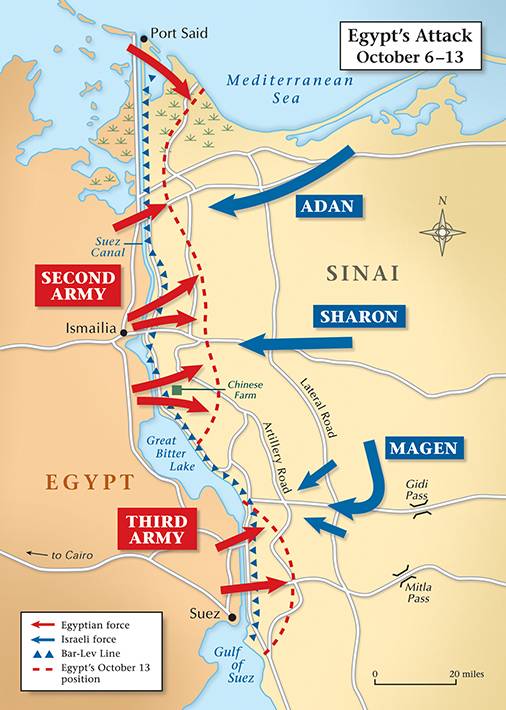
(The map indicates that Magen is commanding the southern sector. The fact is that October 13’s command team M113 Mandler received a direct hit by an Egyptian projectile. He and all members of his staff died. At the post of Mandler I was replaced by General Kalman Magen. My note)
In numbers our forces seemed equal. Eight enemy armored brigades from 960 tanks: Centurions, M-48 and M-60, all armed with 105-mm cannons. We had 1000 tanks: 200 T-62 with 115-mm cannons, 500 T-54 and T-55 with 100-mm cannons, 280 T-34 with 85-mm cannons, 20 light PT-76 lightweight tank systems -JNUMX PT-76 lightweight floating tanks PT-XNUMX. mm cannons. Behind these figures was the fact that now the enemy had a significant advantage.
There were three reasons for this. The first was that in open areas only our T-62s could compete with 105-mm guns of enemy tanks. The second is our eternal weakness in the air. Without air cover, tanks are excellent targets. The third reason was that in order to support our infantry during the initial attack, our armored formations were dispersed among the infantry units. Half of our tanks, in battalions from the 31 tank, were constantly attached to infantry brigades. The other half was divided into brigades of 100 tanks each, assigned to infantry divisions until they could make their fortifications irresistible for a tank counterattack. Our armored forces had little room for maneuver. The enemy could use his tanks as tanks - our own were self-propelled anti-tank guns. The reason for this was not our ignorance. Thus, we wanted to turn our weaknesses into advantages in the fight against the forces of the enemy.
In the next two days, our policy more than justified itself, due to the slow reaction of the enemy. We assumed that he would quickly figure out our tactics. We also foresaw how quickly he would respond: he would use his mobility to concentrate enough forces in front of one of our sectors to defeat one of our bridgeheads. (Of course, we developed reciprocal steps, which, in our opinion, will not allow the enemy to implement this strategy, but it was the best he could do). Time passed, and on Monday, to our amazement, it became clear that instead, the enemy was making a fatal mistake, wasting his strength.
That morning, one armored brigade attacked the positions of the 18 division, and the other - the 2 division. Both attacks were repelled. In the afternoon, the enemy repeated his unsuccessful attempts: two armored brigades struck a concerted blow to the positions of the 16 division in the direction of El Ferdan, another brigade moved to the position of the 2 division in the direction of Deversoire. The latter was completely defeated, and the losses in the battle with the 16 division were only slightly less heavy.
When I drove south past the lakes, as we approached the main bridge of the 7 division, the roads were constantly filled until about a mile from 150 meters before the bridge the traffic jam had not become complete. It soon became clear that, despite the lull on Sunday, the situation in this southern sector had not yet stabilized. We met a lieutenant, who was left alone with his platoon of tanks, who had no idea where the rest of the units were his units. We saw infantrymen without food and water, some of whom were even returning to the west bank to fill their flasks. Most of the problems were due to our inability to drive bridges (problems were caused by mud and current) in the far sector of the 19 division. As a result, the equipment from the 7-th was added to the 19-division technique with which the bridges were already heavily overloaded.
It was necessary to deal with this. But the state of our bridges began to cause me real concern after a conversation with the heads of the engineering units of the Second and Third Armies. During the offensive, we built ten heavy-duty bridges (two were built in the southern sector, but did not function) and kept two in reserve. After the completion of the forcing, we dismantled one heavy duty bridge in the sector of each division and transferred them to the reserve. However, now I learned that enemy air strikes had damaged so many bridge sections that in practice it was equal to the total loss of three bridges. We had four bridges in reserve.
This did not mean that the situation had become critical. But we had to think for weeks, even months of war ahead. If the enemy again and again raids our bridges, it will certainly cost them dearly to the Air Force. But it is also certain that some of the strikes will achieve their goals.
Tuesday 9 October
The enemy stubbornly continued to sacrifice the lives of their tankers. His tanks attacked in small groups, still using the tactics of a cavalry assault. The latest manifestation of this was the attack of two brigades on the position of the 16 division. Again the attack was halted with heavy casualties. In the past two days, the enemy has lost 260 tanks. Our strategy has always been to force the enemy to fight on our terms, but we did not expect him to help us in this.
Wednesday 10 October
Our troops continued to strengthen their positions. The units of the 1 Infantry Brigade, attached to the 19 Division, captured Ayun Musa south of Suez, which was the first in a series of thoughtful stages of moving south along the Sinai Peninsula.
16:45. A message was received from the 2 Division about the attack on its left flank of the battalion of enemy tanks with the support of mechanized infantry. Finally, the enemy changed his tactics. Their tanks broke up into small groups and acted, making good use of the terrain features and strictly following the rules of tactics of small units. They achieved some success, moving more than a kilometer and a half into the beachhead. The enemy managed to be thrown back before dark.
Unfortunately, the underlying vulnerability of our position has been confirmed by other reports we received late in the evening. Our 1 Infantry Brigade lost 90 percent of personnel and equipment. I could not believe it. I just did not understand how this could happen.
I learned everything after I sent the liaison officer to the site: after the capture of Ayun Musa, the brigade was ordered to advance on the night from 10 to October 11 to capture Sudra, the next item in our plan for moving south. The brigade commander, on his own initiative, gave the order to launch an offensive a few hours before sunset. The inevitable happened: in an open area without a fire covering our air defense system, the brigade was defeated by the enemy's air force. Not a single enemy tank and not one field gun even fired. If we needed a reminder of how vulnerable our ground forces are to air strikes from the moment they leave the zone of action of our air defense systems, the devastating result of this battle provided us. We gathered together the remnants of the brigade. Fortunately, the loss of manpower was much less than reported in the first reports. But for several days the brigade ceased to exist as a combat unit.
Thursday 11 October
Now it was clear that the main attack of the enemy was aimed at our central sector. The second army would have maintained its position in the face of the most powerful attack that the enemy could conduct. As a precautionary measure, given yesterday's new tactics to bypass the entire army from the flanks for its surroundings, I ordered our engineers to immediately place the Second Army 10 000 anti-tank mines.
We were disturbed by the ongoing confusion on the bridges. Our ferry commanders acted perfectly during all the crucial hours of our offensive. Subsequent disruptions in the work were due to the fact that the powers of this command in each of the divisions were carried out by the chief of staff. But the chiefs of staffs and their senior officers went forward to the territory of bridgeheads, transferring the control functions of the forcing to junior officers and even non-commissioned officers. As a result, traffic jams were formed when each defended his first-stage right. I decided that the only way out was to transfer control of the forcing to an independent command subordinate directly to me. I seconded a group of high-ranking officers to General Amin and instructed him to organize the crossing of the forces of the Second Army. Brigadier General Munir Sameh got at his disposal the people and the task of doing the same for the Third Army.
I returned to the 10 Center at 16: 30. feeling calmer than ever since the beginning of the offensive. The objective of the operation, which the president repeated at so many meetings of the Supreme Council of the Armed Forces, was achieved. We had a bridgehead in Sinai. He was not invulnerable. Not a single position is invulnerable to a fairly well-organized offensive, as shown by the force we conducted. But our bridgehead was so strengthened that the Israelis would have to pay a price that would have been considered unacceptable to beat us out of positions.
When I entered the hall of the operational situation, they told me that the commander-in-chief, General Ahmed Ismail Ali, wanted to see me. He asked me exactly the question I was afraid of: "Can we not build on our success by attacking the passes?"
This was the first catastrophic mistake of the General Staff, followed by others ...
Продолжение следует ...
Sources: "Arab-Israeli wars. Arabian view." A group of authors. 2008 year.
"Forcing the Suez Canal". Saad al-Shazli. 1979. Translation into Russian 2006 year.
- Alexander Privalov
- Judgment Day. The eve of. Part of 1
Judgment Day. The eve of. Part of 2
Judgment Day. Start. Part of 1
Information